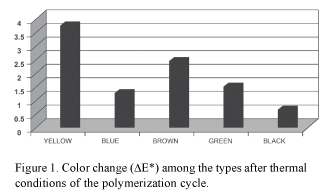Accurate iris reproduction in the fabrication of ocular prosthesis in order to match the remaining eye is a key factor to mask the loss and achieve an esthetic outcome for anophthalmic patients. This study evaluated the stability of acrylic paints used for replicating iris color in ocular prostheses by the analysis of two factors: the temperature of the acrylic resin polymerization cycle during prosthesis fabrication and the incidence of sun light, which is the main photodegrading agent undermining the longevity of ocular prostheses. An accelerated aging assay was used for both analyses. Specimens simulating the prosthetic iris in the colors blue, yellow, black, brown and green were fabricated, and were submitted to a colorimetric reading before and after undergoing the thermal conditions of acrylic resin polymerization. Next, the specimens were submitted to an artificial accelerated aging assay with ultraviolet radiation A and weekly colorimetric readings during a 3-week period. The color change (??*) values for the four specimens painted with the same color paint were averaged and the resulting values were considered for statistical analysis. Levine's test and Student's t-test were used to analyze the influence of the temperature of the polymerization cycle during prosthesis fabrication on the color stability of each acrylic resin paint. Friedman's test for three dependent samples was used for analysis of color photodegradation as function of time. Significance level was set at 0.05 for all analyses. It was observed that, after the action of the temperature of the polymerization cycle, alteration above clinically acceptable level of ??*> 3.3 was observed only for the yellow color. After the accelerated aging assay, there were statistically significant differences (p<0.05) as a function of time in the green, brown, black and blue colors. Changes were clinically acceptable for the brown and black colors; slightly above the clinically acceptable limit for the green color; and significantly high and impracticable from a clinical standpoint for the blue color. There was no statistically significant differences (p>0.05) for the yellow color, which presented color change only a little above the clinically acceptable limit. In conclusion: 1. Only the yellow color presented alterations above the clinically acceptable levels after the polymerization cycle; 2. After accelerated aging, there was no changes in the yellow color above the clinically acceptable levels; 3. For the green color, degradation was significant and slightly above the clinically acceptable levels; 4. The black, brown and blue colors presented significant alterations as function of time; the alterations of the brown and black colors were within acceptable clinical levels, while the blue color presented a more accentuated degradation over time.
ocular prosthesis; iris painting; color stability


